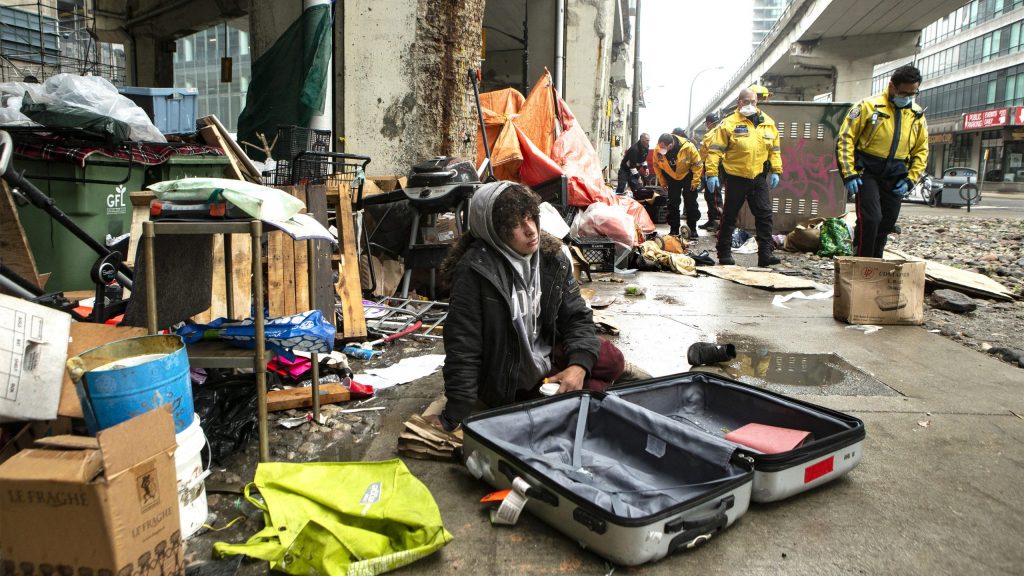Toronto works to remove makeshift homeless encampments despite pleas from city advocates

Posted March 9, 2021 4:01 pm.
Last Updated March 9, 2021 10:50 pm.
A battle ensues between the City of Toronto and homeless advocates as makeshift shelters are being removed in many parks.
The City operates under the grounds that if they determine the shelter has been abandoned, they can remove it. Officials must visit these encampments multiple times before going through the process of taking them away.
Outreach volunteer Ginger Dean tells the Toronto Star that recently, one occupant of these makeshift shelters had moved to a City-run facility but wanted to keep the one they had in case they were forced out and needed somewhere to go.
City spokesperson Brad Ross says the decision to remove these shelters is being done in an effort to influence those experiencing homelessness to take refuge in a Toronto-run shelter instead.
“We continue to work with people experiencing homelessness to come into safe, indoor space,” Ross said in an email to 680 NEWS. “When they do, we remove any structures or tents in the park.”
Ross says City crews are only disposing of abandoned structures, verified by two checks, 48-hours apart.
“We don’t want those structures then to be reoccupied. If they’ve been abandoned, we are going to remove them,” Ross says.
The shelters are illegal, and the City maintains they are also unsafe–it even got a court injunction against a local carpenter who was building some wood structures last month.
Long-time street nurse Cathy Crowe disagrees, “some of these structures are safer shelters than what the city is providing, so the City, in my opinion, is really intentionally causing harm.”
The City issued a series of tweets on Tuesday in which they shared the story of a man named Derrick, who found himself homeless in early 2020.
“He didn’t feel safe accessing the shelter system and so like many, set-up in Moss Park encampment. Derrick worked with the City of Toronto’s Streets to Homes team (S2H) & Street Outreach Counsellor Brent to secure a 1-bedroom in the Moss Park area,” they said.
Derrick’s sharing part of his journey. He now reunited with his 3 cats including 2 that were sleeping under the couch & Munchkin shown in the photo. In the early part of the pandemic, he was one of the first people to take to parks in an effort to stay safe & distant.
— City of Toronto (@cityoftoronto) March 9, 2021
The City says Derrick, who was known by many as The Mayor of Moss Park, “believed it was his right to remain in the park until he was able to secure safe and adequate housing.”
“… He’s thankful to City for support to help him find appropriate housing & looks forward to spending quality time with his cats in [the] warmth and comfort of his new home,” the thread ends by saying.
Khaleel Seivwright has been building small wooden shelters in Toronto since the fall, having raised more than $200,000 through a “GoFundMe” page for materials but recently announced he’s been forced to stop building them as the City works to obtain a court injunction to stop him from making the shed-like structures.
“The problem is not the tiny shelters. The problem is that Toronto’s most vulnerable people are falling through the cracks,” Seivwright said.
Ross has acknowledged the injunction, saying “wooden structures or any encampment on any city property is not permitted.”
As of March 3, the City has counted 274 structures in 38 parks and 42 structures at other sites, according to the Star.
In February, a man died in a fire in one of the units set up at an encampment in Orphans Green Park, near Adelaide and Parliament streets.
There have been renewed calls for change to the way the City treats homeless residents ever since the man’s death.
RELATED: 43 people at Seaton House homeless shelter have COVID-19, city says
Lorraine Lam, an outreach worker with Sanctuary Ministries Toronto, said recently that many people living outside have nowhere to go.
“This is a huge failure by the city,” Lam said.
“These encampments are last resorts, no one is celebrating living outside and this points to the deeper issue of the housing inaffordability crisis.”
Advocates say there are about 1,000 people living outdoors, perhaps more.
In 2020, Toronto Fire Services said they responded to 253 fires in encampments – a 250 percent increase over the same period in 2019.
So far this year, there have been 27 fires in encampments.
Homeless encampments have popped up throughout the City as hundreds continue to flee shelters for fear of contracting COVID-19.
Multiple outbreaks have been reported across these shelters, including at Maxwell Meighen Centre.
Prior to the pandemic, Maxwell Meighen had enough room for 363 homeless men but the number has been reduced to 256 during the pandemic to allow enough space for physical distancing.
There are 11 active COVID-19 outbreaks in the City’s near capacity shelter system.








